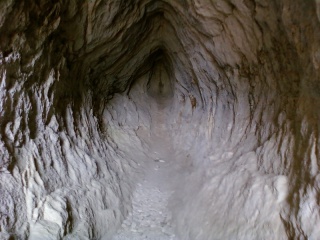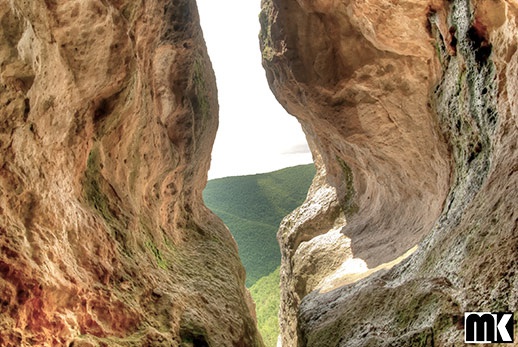Traveler's Guide
East Macedonia & Thrace
Cave Womb

It is an artificial cave. The locals call this Dangardak Kaya (stone). The name itself comes from the impressive acoustic echo inside the cave.
The entire cave is literally shaped like female genitalia and fully matches the description of womb-caves researched by the Bulgarian historian and Thracologist Professor Alexander Fol. The length of the cave is 22 mеtres. The first 16 metres of the cave are formed of natural karst. It is a natural split in the rocks. The last 6 metres were hollowed out and the shape adapted to become an anatomical female symbol. The height of the entrance is 3 metres and the width is 2.5 meters so there is enough light coming from the outside.
At the north end of the cave, there is a man-made altar which symbolizes the womb. Water drips from the cave and collects in a small pool at the base. This water never dries out. In the Thracian religion (Orphism), cult locations were always at the peak of a mountain housing a cave with drizzling water. Therefore, for the Thracians, this cave was a symbol of the womb, conception and rebirth.
At noon, a ray of light penetrates through a crack in the ceiling and it is projected onto the floor. A perfectly shaped solar “phallus” is formed and directed toward the altar-uterus. This happenes only during certain times of year when the sun is low in the north and the ray of light may be long enough to symbolically fertilize womb. According to the Thracian beliefs, this is the conception of the new sun god. This cave is considered a complex astronomic facility (compared to Stonehenge in Great Britain) as the ray of light enters the cave on a single day of the year. It usually happens in January or February.
It is assumed that this is an ancient Thracian temple, where they performed divine mystery cults called Dionysian orgies. Dionysian orgy allowed the Bacchant to emerge from the "ego" and be temporarily united with the god in an ecstatic exaltation, dancing and wine.Thousands of Thracian altars have been found in Bulgaria, but such a womb-cave, which explains Orphism, has not been found anywhere else in the world. The Bulgarian archeologist Prof.Ovcharov believes that the cave is a proof of Dionysian orgies, in which the Trachian young women participated in order to plead for fertile crop.
Similar events have been narrated by Evripid (480 г. – 406 г. B.C.) in his play ‘Vakhankite’ ( “ The Maenads”). The famous historian Heredot also mentions the orgies and describes immorally behaved young women.Now three thousand years later it is impossible to say whether these events do represent immoral behaviour or they were a result of religious rituals, performed by certain priestess to please God Sun and Goddess Mother.
Similar caves existed during the Copper Age in the fourth millennium BC. There is written evidence showing that such caves were temples of the Mother Goddess. The cult is associated with the so-called hierogamiya -- the belief that the Thracian king must symbolically die and be reborn for the New Year to come. The ritual included the following: The King went up into the mountains, on the rocks, where a black animal such as a goat, a horse or a bull was offered as a sacrifice. This symbolized his death. Then he entered into a symbolic marriage with the goddess-mother, fertilized her, and so the new world began. The idea was for the son-lover to enter into intercourse with the mother in the cave-womb. This ritual was performed in January and February during Bacchanalia( the wild and mystic festivals of the wine god).
People also believed that Saint Marina inhabited a cave with drizzling water, which symbolized the fertility fluid flowing into the womb. Legends say that the mother of the Virgin Mary was childless and asked the Sun for assistance. Once a year, bachelors and maidens gathered in these caves in order to participate in the mystery of conception. There is also a belief that those who visit the cave will remain childless. Perhaps it was this dark rumor that helped preserve the cave that tells so much about the ancient rituals of the people inhabiting the Holy Rhodope Mountains. And perhaps, this was also the way to keep those who were not dedicated in the mysticism and mystery of the mountain away from this "holy, sacred place".
Address
No information available.Contact Information
No information available.








